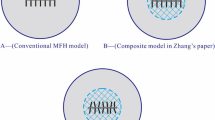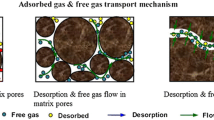Abstract
The well plant operation mode with high integration degree is widely adopted for shale gas reservoir development. In order to study the production dynamics of fractured horizontal wells in staggered placement mode, multiple seepage mechanisms of shale gas at the microscopic scale are considered, and a reservoir-fracture-wellbore coupled point source function flow model is developed based on the pressure drop superposition principle to investigate the factors influencing the production capacity of fractured horizontal wells in staggered placement mode. The study shows that not considering the microscopic seepage mechanism will overestimate the production of shale gas fractured horizontal wells, in which viscous flow makes the largest contribution to gas flow; the larger the overlap area of adjacent gas well modifications, the smaller the gas well production, and the decreasing production increases with the increase of the overlap area, so shale gas production platforms should avoid the overlap of modifications between adjacent wells; with the increase of well spacing, the gas well production increases, but the increase gradually decreases. The optimal well spacing exists between platform production wells. The study considers the microscopic seepage mechanism of shale gas and combines the fractured horizontal well capacity model to realize the study of the capacity dynamics of staggered fractured horizontal wells, which provides a reference for the study of multi-well production capacity.
Access this chapter
Tax calculation will be finalised at checkout
Purchases are for personal use only
Similar content being viewed by others
References
Zou, C., Xiong, B., Xue, H., et al.: The role of new energy in carbon neutral. Petrol. Explor. Develop. 48(2), 1–10 (2021)
Zhang, J., Tao, J., Li, Z., et al.: Prospect of deep shale gas resources in China. Nat. Gas. Ind. 41(1), 15–28 (2021)
Zou, C., Zhao, Q., Cong, L., et al.: Development progress, potential and prospect of shale gas in China. Nat. Gas. Ind. 41(1), 1–14 (2021)
Jiao, F.: Re-recognition of “unconventional” in unconventional oil and gas. Petrol. Explor. Develop. 46(5), 803–810 (2019)
Guo, X., Hu, D., Wei, Z., et al.: Discovery and exploration of Fuling shale gas field. China Petrol. Explor. 21(3), 24–37 (2016)
Zhang, J., Fan, Q., Wang, Y., et al.: mixed large well pattern development technology of tight sandstone gas in Sulige Gas Field Ordos Basin. Xinjiang Petrol. Geol. 40(6), 714–719 (2019)
Vandenbroucke, M.: Kerogen: from types to models of chemical structure. Oil Gas Sci. Technol. 58(2), 243–269 (2003)
Luan, H.B., Xu, H., Chen, L., et al.: Evaluation of the coupling scheme of FVM and LBM for fluid flows around complex geometries. Int. J. Heat Mass Transf. 54(9), 1975–1985 (2011)
Su, Y., Sheng, G., Wang, W., et al.: A multi-media coupling flow model for shale gas reservoirs. Nat. Gas Indust. 36(2), 52–59 (2016)
Zhang, L., Shan, B., Zhao, Y., et al. Establishment of apparent permeability model and seepage flow model for shale reservoir. Lithol. Reserv. 29(6), 108–118 (2017)
Civan, F., Rai, C.S., Sondergeld, C.H.: Shale-gas permeability and diffusivity inferred by improved formulation of relevant retention and transport mechanisms. Transp. Porous Media 86(3), 925–944 (2011)
Wu, K., Chen, Z., Li, X., et al.: Real gas transport through nanopores of varying cross-section type and shape in shale gas reservoirs. Chem. Eng. J. 281(6), 813–825 (2015)
Ren, L., Shu, L., Hu, Y., et al.: Analysis of gas flow behavior in nano-scale shale gas reservoir. J. Southwest Petrol. Univ. (Sci. Technol. Ed.) 36(5), 112–115 (2014)
Ren, W., Li, G., Tian, S., et al.: An analytical model for real gas flow in shale nanopores with non-circular cross-section. AIChE J. 62(8), 2893–2901 (2016)
Wu, K., Li, X., Chen, Z.: A model for gas transport through nanopores of shale gas reservoirs. Acta Petrolei Sinica 36(7), 837–848 (2015)
Li, Y., Liu, X., Hu, Z., et al.: Summary of numerical models for predicting productivity of shale gas horizontal wells. Adv. Earth Sci. 35(4), 350–362 (2020)
Hu, Y., Pu, X., Zhao, J., et al.: Production simulation of staged multi-cluster fractured horizontal wells with complex hydraulic fracture in shale gas reservoirs. Nat. Gas Geosci. 27(8), 1367–1373 (2016)
Zhao, Y., Zhang, L., Shan, B.: Mathematical model of fractured horizontal well in shale gas reservoir with rectangular stimulated reservoir volume. J. Nat. Gas Sci. Eng. 59(2), 67–79 (2018)
Yao, J., Sun, H., Fan, D., et al.: Transport mechanisms and numerical simulation of shale gas reservoirs. J. China Univ. Petrol. 37(1), 91–98 (2013)
Guo, X., Zhou, C.: Seepage numerical model for fractured horizontal well in shale gas reservoir. J. Southwest Petrol. Univ. (Sci. Technol. Ed.) 36(5), 91–96 (2014)
Song, H., Yu, M., Zhu, W., et al.: Numerical investigation of gas flow rate in shale gas reservoirs with nanoporous media. Int. J. Heat Mass Transfer 80(20), 626–635 (2015)
Cai, J., Lin, D., Singh, H., et al.: Shale gas transport model in 3D fractal porous media with variable pore sizes. Marine Petrol. Geol 98, 437–447 (2018)
Acknowledgments
This work was supported by the China Postdoctoral Science Foundation (No.2020M673287), Science and Technology Cooperation Project of the CNPC-SWPU Innovation Alliance (Grant No. 2020CX030202).
Author information
Authors and Affiliations
Corresponding author
Editor information
Editors and Affiliations
Rights and permissions
Copyright information
© 2022 The Author(s), under exclusive license to Springer Nature Singapore Pte Ltd.
About this paper
Cite this paper
Huang, X., Zhang, Rh., Zhang, Lh., Zhao, Yl., Yuan, S. (2022). Study on the Productivity of Fractured Horizontal Wells in Shale Gas Reservoirs Considering Staggered Fracture Model. In: Lin, J. (eds) Proceedings of the International Field Exploration and Development Conference 2021. IFEDC 2021. Springer Series in Geomechanics and Geoengineering. Springer, Singapore. https://doi.org/10.1007/978-981-19-2149-0_60
Download citation
DOI: https://doi.org/10.1007/978-981-19-2149-0_60
Published:
Publisher Name: Springer, Singapore
Print ISBN: 978-981-19-2148-3
Online ISBN: 978-981-19-2149-0
eBook Packages: Earth and Environmental ScienceEarth and Environmental Science (R0)




